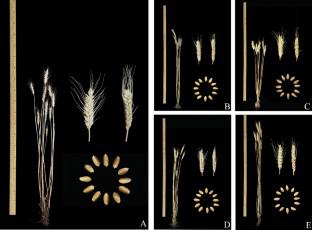Molecular Breeding ( IF 3.1 ) Pub Date : 2024-03-26 , DOI: 10.1007/s11032-024-01467-8 Ya Zhao , Guohao Han , Yanmin Qie , Jianmin Song , Yan Zi , Bei Xiao , Jiaojiao Wang , Zejun Qian , Xiaomei Huang , Ruishan Liu , Jiadong Zhang , Lihong Song , Yuli Jin , Pengtao Ma

|
Powdery mildew, caused by Blumeria graminis f. sp. tritici (Bgt), is a severe disease that affects the yield and quality of wheat. Popularization of resistant cultivars in production is the preferred strategy to control this disease. In the present study, the Chinese wheat breeding line Jimai 809 showed excellent agronomic performance and high resistance to powdery mildew at the whole growth stage. To dissect the genetic basis for this resistance, Jimai 809 was crossed with the susceptible wheat cultivar Junda 159 to produce segregation populations. Genetic analysis showed that a single dominant gene, temporarily designated PmJM809, conferred the resistance to different Bgt isolates. PmJM809 was then mapped on the chromosome arm 2BL and flanked by the markers CISSR02g-1 and CIT02g-13 with genetic distances 0.4 and 0.8 cM, respectively, corresponding to a physical interval of 704.12–708.24 Mb. PmJM809 differed from the reported Pm genes on chromosome arm 2BL in origin, resistance spectrum, physical position and/or genetic diversity of the mapping interval, also suggesting PmJM809 was located on a complex interval with multiple resistance genes. To analyze and screen the candidate gene(s) of PmJM809, six genes related to disease resistance in the candidate interval were evaluated their expression patterns using an additional set of wheat samples and time-course analysis post-inoculation of the Bgt isolate E09. As a result, four genes were speculated as the key candidate or regulatory genes. Considering its comprehensive agronomic traits and resistance findings, PmJM809 was expected to be a valuable gene resource in wheat disease resistance breeding. To efficiently transfer PmJM809 into different genetic backgrounds, 13 of 19 closely linked markers were confirmed to be suitable for marker-assisted selection. Using these markers, a series of wheat breeding lines with harmonious disease resistance and agronomic performance were selected from the crosses of Jimai 809 and several susceptible cultivars.



























 京公网安备 11010802027423号
京公网安备 11010802027423号